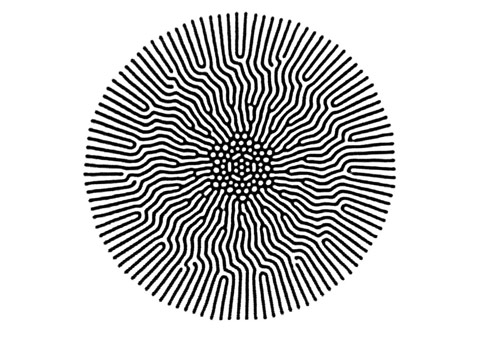SciArt 2012 Mysterious
UCSB’s Kavli Institute Hosts Contemporary Art Exhibition

UCSB’s Kavli Institute for Theoretical Physics (KITP) is housed in a magnificent postmodern Michael Graves building perched just beyond the main entrance to campus on a bluff overlooking the Pacific. All by itself, the KITP is a truly impressive statement of the university’s commitment to the cutting edge of scientific thought. What even regular visitors to the KITP may not anticipate, however, is the additional presence there of first-class contemporary art, curated with intelligence and verve by artist-in-residence Jean-Pierre Hébert, a pioneer in the field of computer program–generated drawing. The institute supports both a permanent collection that includes a pair of Richard Diebenkorns and a Josef Albers and an annual group show that goes by the name SciArt.
This year, SciArt 2012 carries the subtitle Mysterious and includes work by Hébert, Ethan Turpin, Tatiana Ginsberg, Vera Molnar, and Jeremy Sarchet. On Thursday, November 15, four of the five artists were present for a panel discussion that was moderated by art critic Peter Frank. Molnar, who is now in her eighties and lives in Paris, was not able to attend, but Hébert, who discussed her technique, which involves “genetic system altering in a stepwise manner affecting the dimensions, proportions, and arrangements of shapes,” represented her computer art with a flair far in excess of such dry descriptions of her process. Hébert was particularly insistent on Molnar’s role in establishing the field of computer art back when the average computer was the size of a room, not the size of an iPhone.
Santa Barbara resident and multimedia artist Turpin spoke for a more recent generation that, while still scientifically inclined, remains more closely connected to what’s happening in mainstream galleries and museums. Turpin refers to the richly detailed prints that he is showing in Mysterious as “fossils” because they are abstract shapes derived from momentary patterns established by video feedback, but also because they resemble the actual fossils that he has been borrowing from the Santa Barbara Museum of Natural History and showing alongside them. This series of pictures of pixels with the clever name of “Video Feedbackteria #s 1, 2, and 3” read like black-and-white mandalas and tend to induce a blissfully meditative state. Turpin has a related exhibit on view now at the Santa Barbara Contemporary Arts Forum that allows visitors to interact with the video feedback loop he set up to create the images, and taken together, along with the funky kaleidoscope he’s also showing now at KITP, these pieces represent one of the more substantial and thought-provoking bodies of work produced hereabouts in the last decade.
Recent UCSB undergraduate Sarchet has used his training in physics as a source for his work, which observes and records images of systems seeking to restore their equilibrium, such as trees that sway and vibrate in the wind. Sarchet studied with Hébert as a fellow at the Kavli Institute, and his mentor’s seriousness of purpose and imaginative relation to the big ideas of physics shines brightly in him, as well.
The highlight of the panel came during Ginsberg’s quietly compelling talk about the way that she has brought together her expertise in making fine paper with her interest in the worlds that become visible through leaps in scale. In Ginsberg’s recent work, the tiny geometric tracks left on glass by snails become the basis for incredibly elegant, disarming prints and scintillating cut-paper installations. In an atmosphere conditioned by the presence of many mighty brains, these five artists and their work feel very much at home.



